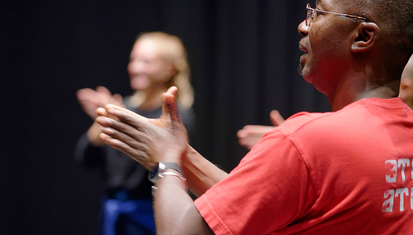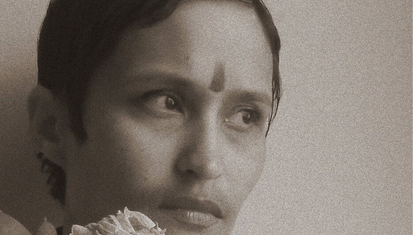Artistic Research – New Pathways to New Knowledge? A conversation with Catalina Insignares
It’s no secret that artistic research takes place at the Academy of Theatre and Dance, but what does it actually involve? In this ninth episode in a series of interviews, we take a look behind the scenes, in conversation with Brussels-based Colombian choreographer Catalina Insignares,* a fellow of the THIRD program at DAS Graduate School.
Part 9: A ballroom for the dead
When we meet on Zoom, Catalina is in Brussels, having just returned from Colombia.The blouse she’s wearing belonged to her grandmother, whose funeral she recently attended. In her grandmother’s final days, Catalina flew back to Bogotá to be with her. ‘Two aunts and a cousin have died since I’ve been living in Europe, and I couldn’t be there for them,’ she explains. ‘I knew that the next time I would go back.’
‘I lost three family members in quick succession a few years back. I felt cut off from them, and very dejected. Then I discovered Au bonheur des morts by the Belgian philosopher Vinciane Despret. It’s a wonderful book about how our relationship with death goes a lot further than grief as it’s perceived by psychologists: as something to go through and then move on. Despret describes all sorts of ways in which the living and the dead maintain a relationship, such as through the deceased communicating a message in a dream, or the living carrying the dead around with them in daily life, or trying to contact them through séances or channelling.
‘Au bonheur des morts opened up a path for me to connect directly with the dead. As well as being about my own experiences, I wanted to find out what sort of social space I could create to open up the potential for dialogue with these voices. My 2015 dance us as a useless duet, for one performer (me) and one participant, was also about unseen things. It was through that work that I discovered how much it was possible to make palpable in the affective space between me and the other person – and how much information could be passed on by dancing together.’
In ‘of the dead’ in 2018?
Yes. What I was trying to do was get the ‘spectator’ to lie down and think about someone who was dead, and meanwhile I’d physically touch them, like I was massaging them, in a playful way – I’d pull and push and explore. Then I invite images to come to me in the form of a landscape. It could range from a river to something totally abstract, like a blue square. And whatever I see I describe in detail, like maybe, “Oh, I can see a cigarette butt.” There’s space for humour, for absurdity. That’s part of the work. We play with the idea that the landscape is the form adopted by the living person’s relationship with the dead person, in the here and now. It was sometimes really rich with meaning. One of them said, ‘That is so like grandma!’ Something always resonates. These encounters are very charged, very intense.
On a residency I was doing in Colombia in summer 2021, I wanted to take my research a step further, working with Carolina Mendonça, who I’ve been collaborating with intensively for many years. It soon became clear that we were going to have to let go of the one-on-one relationship with the spectator. You know how it works: you start talking about someone you’ve lost, and that opens the door for the person you’re with to talk about the dead people in their lives. And all those other dead people also show up. This kept on happening in Colombia, because of the many violent deaths in the country. We really needed a collective space there, to support the conversation with the dead. Carolina and I had previously made a production for a large group of people in which we read aloud throughout the night while they slept [useless land, 2018]. Lots of our work is about listening. That’s how we came to make To know the vultures so well.
How does that piece work?
There are six loudspeakers, and when the audience come in we ask them to think about someone who has died with whom they have a relationship. If a song related to that person comes to mind, they can bring it to us.
So in addition to our own playlists with tracks for our own dead and those of friends, we were able to compile an audience playlist. We give everyone a pair of sunglasses and a booklet containing a collage of text fragments from the journal of our residency in Colombia, together with other texts from our research.
Why the sunglasses?
So people don’t have to make eye contact. But also because there’s something funny about them. They make everyone look slightly ludicrous – as if we’re in the Matrix or something. We form a circle – a strange, sunglass-wearing funereal circle – with the six loudspeakers around the circle. And we explain beforehand that all the tracks we’re going to play have a connection with a dead being, and that all these beings are now present. Then we play each playlist through a different speaker at the same time It’s a time of grieving, a performance, a practice, and a form of ritual.
How many people are involved?
When we did it in Berlin last August, there were 50 people participating. While the music’s playing, Carolina moves the speakers around so they’re nearer to some people and further from others, and we turn the volume of some voices up or down. A strange sort of gap opens up in time, with some songs being for people who died years ago, and others for people who I think will die soon. It’s not just for people by the way, because you can also do it for animals and other living beings.
How do people experience this piece?
Everyone finds it pretty intense. Somebody said, ‘It’s a difficult gift, but it is a gift. It was noisy and too much, but thank you.’ And someone else said, ‘It was like a ballroom for the dead. I was thinking of someone, but they were joined by more and more dead people.’ Some people cry the whole time, but others laugh. The space gets crowded with all those singers and dead people. Sometimes it’s like Madonna is singing a duet with Juan Gabriel. It is all composed to a certain degree, but there are many beautiful and moving moments that happen through randomness. It turned out that Kendrick Lamar’s ‘United in Grief’ uses the same drumbeat as an African Colombian track we recorded at the beach. By bringing them together, we claim that there is a connection between them, that there’s something shared.
So you’re saying the dead are really present?
Yes, I think so. My friend Léa Rivière says: ‘We invoke the dead whenever we talk about them.’ In this case we do it with sound. I do believe they’re present in one way or another.
Why do you do this work?
It’s a process that takes years. I think it’s about remembering, about ‘remembering’ knowledge and skills that have been lost in western civilisation. In recent years, I and my collaborators Carolina Mendonça and Myriam Lefkowitz, and others, have been training our sensory intuition. For example, in other works we ask whether we can get in contact with people through our dreams. Who knows? We’re just opening up a space, a possibility. And people are often grateful for that, and for the contact with the darkness, with difficult or sad things. There’s such a big need to be together in discomfort these days, I think, to be together with one other person or a group, when you’re feeling vulnerable and uneasy.
[silence]
Maybe it sounds pretentious, but I believe that this work should be done by many others as well as myself, to reconnect us with the invisible layers. But, yeah, it keeps on getting crazier [laughs] – crazier and more commonplace. First I thought ‘Woah, I’m making contact with a dead person!’ and I was really scared. Now I just think ‘So what? Why not?’ [laughs].
Everything speaks; the air that passes and the kingfisher that sails by
the blade of grass, the flower, the germ, the element. [...]
[...] everything is a voice and everything is perfume;
Everything says, in the infinite, something to someone;
Victor Hugo
(from the booklet accompanying To know the vultures so well)
* Work by Catalina Insignares and her cohort will be on show at DAS THIRD Annual Forum from 26 to 29 October 2022.
Interview by Hester van Hasselt
![[Translate to English:] [Translate to English:]](/media/the/pics/2017-19/nieuws/insignares-web.jpg)







